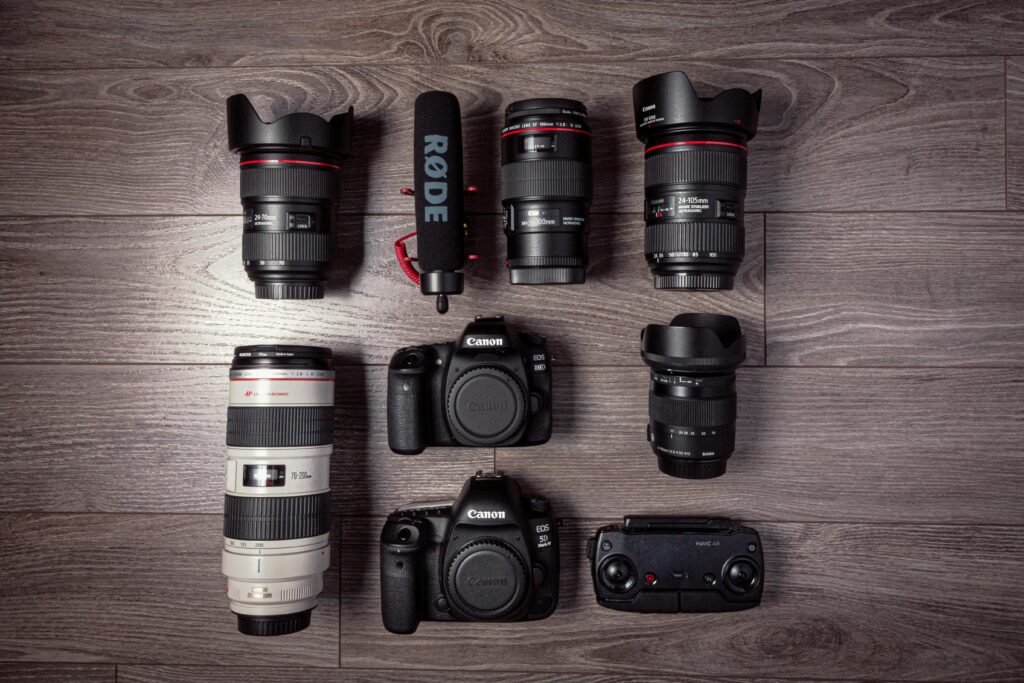Regarding photography, Canon lenses are must-haves for everyone, from amateurs to professionals. There are many choices; figuring out which lens is best for you can take effort. We will discuss the different kinds of Canon lenses and help you determine which ones work best for you.

Normal Glasses
Standard lenses can be used for many things and are great for everyday photos. They’re often called “kit lenses” since many Canon cameras come with them. The Canon EF 50mm f/1.8 lens is a well-known example. Photos of people and other things can be taken with this lens. It can be used in low light and takes pictures with many precise details.
Lenz Zoom
A zoom lens’s focal length can be changed, so you can zoom in and out to see different picture parts. The Canon EF-S 18-55mm is a well-known zoom lens. This lens is excellent for people just starting with photography because it lets you take wide-angle and close-up pictures.
Large-View Lenses
Wide-angle lenses capture wider scenes, which makes them great for photographing scenery and buildings. Many people choose the Canon EF 16-35mm f/4L because, with this lens, you don’t have to stand back to take photos of big scenery or tall buildings.
Lenses for Telephoto
Telephoto glasses are made to help you take pictures from far away. Many people use them for events, sports, and wildlife. Many people like the Canon EF 70-200mm f/4L zoom lens. It lets you get close to things that are far away, which makes it great for taking pictures of animals or sports in action.
Lenses for Macro
Macro glasses are designed to take pictures up close. You can get photos of tiny things that other lenses miss with these lenses. The Canon EF 100mm f/2.8L Macro is a great lens for taking pictures of small things like flowers, bugs, and complicated things. You can see every little thing very clearly with this lens.
The Best Lenses
Prime lenses can’t zoom in or out because their focal length is set. However, their pictures are often more precise than those taken with zoom lenses. The Canon EF 85mm f/1.8 is an excellent prime lens for portraits. The blurred background looks great and makes the subject stand out.
How to Pick the Right Lens
Think about the shooting you like before you buy a Canon lens. A standard lens like the 50mm f/1.8 might work well if you take pictures daily. If you want to take photos of nature or sports, there might be a better lens for you. A wide-angle lens is the best way to get beautiful images of landscapes. A macro lens will also give you new ways to look at small things for the first time.
Different Lenses
Canon makes more than just the most common types of lenses. They also have speciality lenses for specific types of shooting needs.
Fisheye Lenses
A fisheye lens allows you to see a vast area, giving your photos a unique, bent look. It also lets you take creative pictures to capture the whole scene in one shot. Many shooters choose the Canon EF 8-15mm f/4L Fisheye to give their pictures a fun and artistic look.
Lenses that tilt and shift

Tilt-shift lenses are mainly used for taking pictures of buildings. Building buildings don’t look like they’re leaning because they let you change the image’s view. That’s the Canon TS-E 24mm f/3.5L II, which is an excellent tilt-shift lens. It helps photographers take shots of buildings with straight lines and the correct size.
Extras for the Lens
You should find valuable extras for your Canon lenses to get the most out of them.
Lens Covers
Lens caps cover the front of your lens to keep out light you don’t want and reduce glare. They also protect your glass in some way. The hood that comes with most Canon lenses is made to fit correctly.
Filters: Filters can change how your photos look by changing light and colour. Various filters, such as polarising filters, improve colours and reduce shadows. UV filters protect your lens. If you use the right filter, your pictures will look much better.
Clean-up kits and lens caps
Take care of your glasses to keep them in good shape. Protect the glass on your lens by always putting on a lens cap when it’s not in use. Regularly using a lens cleaning kit can prevent dust and smudges from ruining your pictures.
How to Choose the Right Canon Lens
If you want to buy the best Canon lens, keep these tips in mind:
Budget: The price of lenses can change a lot. Choose a price range and then look for the lens that gives you the most for your money.
Goal: Think about what you’ll be shooting most of the time. This information will help you pick a lens that works for you.
Compatible: Check if the lens works with your Canon camera and ensure the lens mount type works with your camera model.
Read reviews and look at pictures taken with the lens as examples. This will show you how well it works and how good the images are.
Try Before You Buy: If you can, try the lens in a camera shop. This can help you decide if it’s the right lens for you.
In conclusion
Canon has many lenses to choose from for different types of photos. You can choose which lens to add to your camera bag better if you know about the basic kinds of lenses and how they are used. Any Canon lens will help you take beautiful pictures, shooting people, scenery, or close-ups.
Anytime you want to take pictures of everyday things, beautiful scenery, faraway animals, or small details, Canon has a lens to help you do it. Getting the right lens and other photography gear can make a big difference in the pictures you take and how much you enjoy the hobby.